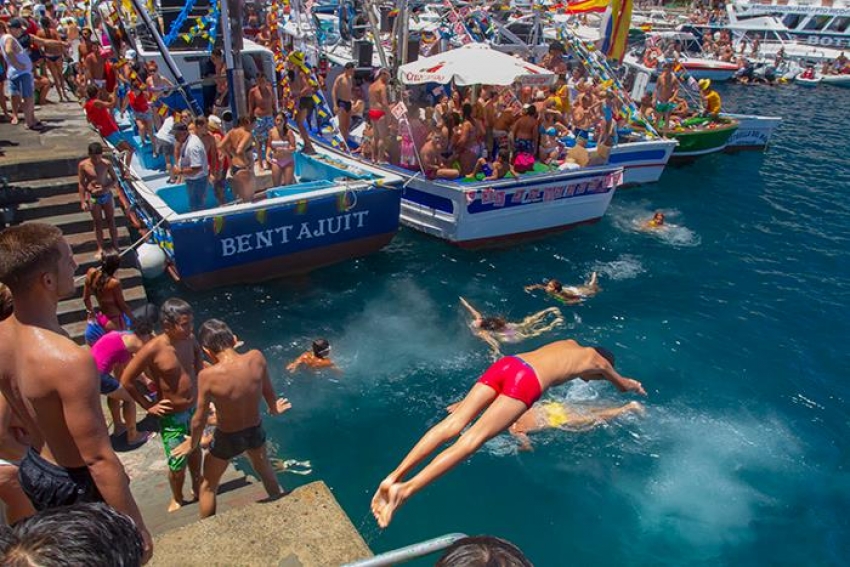Fiestas del Carmen
Our Lady of Mount Carmel is the patron saint of fishermen and the Fiestas del Carmen are huge in fishing harbours and seaside villages all over Gran Canaria. Celebrations normally include fireworks, a religious parade where the town's Carmen icon is paraded around the streets and out to see chaperoned by a flotilla of boats, and plenty of music and fun.
The biggest event is in Arguineguín with a programme of events in mid-July and a huge boat parade between Arguineguín harbour and Puerto de Mogán marina.
Other places that celebrate the Fiestas del Carmen include Puerto de las Nieves and the La Isleta barrio of Las Palmas.
Agaete's fiestas last for a month and while the main La Rama and Bioagaete events are in August, there's always something going on in town during the last week of July.
Pozo Wind & Waves Festival
The international windsurfing world decamps to Pozo Izquierdo in July for a world cup event and the Wind & Waves Festival. It's well worth dropping in on Pozo during the week as it looks fantastic with all the flags blowing and the windsurfers practising offshore. Highlights for non-windsurfers include a live music, daily performances and lots of cold beer.
Temudas Fest
Gran Canaria's international theatre, dance and music festival happens in July and August in the capital Las Palmas de Gran Canaria. There are daily events and many are outdoors and free to watch.
Temudas Fest website and program.
Finca Festival
The Finca World Piano Festival is hosted at the Justus Frantz Finca in Monte León (the Beverly Hills of Gran Canaria) overlooking Maspalomas. It's a world-class piano event hosted by noted composer Justus Frantz and features.
Apricot Festival
Pretty Fataga village in the hills behind Playa del Inglés celebrates everything to do with the apricot at the end of June and beginning of July. The main event is a romeria-style parade dedicated to all things apricoty.
Onion Festival
Galdar hosts it's annual onion festival in July. There's a market in the centre of town and all the bars in the old town serve tapas and tasters with an onion theme. Look out for the miniburgers; they are fantastic.
Mud Festival
La Atalaya village in north-east Gran Canaria was famous for it's hand-made pottery and cave houses and once even featured in National Geographic magazine. Nowadays it's surrounded by vineyards and posh houses but still keeps up its annual Traida de Barro festival. The traditional comes from the route the Atalaya locals had to follow to get the clay they needed to make their pots. Everyone follows the route and brings clay back to the village, then has a mud fight.
Teror Water Festival
Teror is most famous for its Fiestas del Pino that celebrate the island's Virgn del Pino patron saint in September. However, Canarians don't need much of an excuse to start a three week party so Teror also celebrates its water festival in July. In 2015 this runs between July 3 and 26 but really gets going in the last two weeks. The 2015 events calendar is here.
The main events are a fireworks display, a livestock feria and arraste competition (arraste is a traditional farming sport involving teams of oxen dragging a wooden sled), and a handicrafts market.
In July, Teror also hosts a series of salsa concerts and events called the Festival Latino Villa de Teror. Arrive any evening during this period and there will be salsa going on somewhere in Teror.
Romerias
Here's a list of the most important romerias in Gran Canaria during July.
On the second Saturday in July, there are romerias in San Isidro in Teror, La Milagrosa village close to San Lorenzo, Las Huesas in Telde, Risco Blanco in the San Bartolomé highlands, Arguineguin, Marpequeña in Telde, Santa María de Guía, and Teror.
On the third Saturday of July, there are romerias in La Banda in Agüimes, La Isleta Barrio in Las Palmas, Galdar, Telde and Santiago de Tunte.
On thr fourth Saturday in July there are romerias in Las Bachilleras in Telde and Punta Fielato in Telde.














